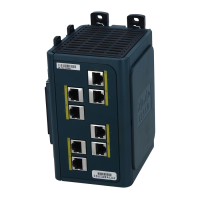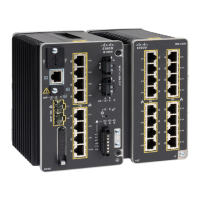701
Configuring IP Multicast Routing
Configuring IP Multicast Routing
To remove the PIM device configured as the candidate RP, use the no ip pim send-rp-announce interface-id global
configuration command. To remove the switch as the RP-mapping agent, use the no ip pim send-rp-discovery global
configuration command.
EXAMPLE
This example shows how to send RP announcements out all PIM-enabled interfaces for a maximum of 31 hops. The IP
address of port 1 is the RP. Access list 5 describes the group for which this switch serves as RP:
Switch(config)# ip pim send-rp-announce gigabitethernet0/1 scope 31 group-list 5
Switch(config)# access-list 5 permit 224.0.0.0 15.255.255.255
Preventing Join Messages to False RPs
Find whether the ip pim accept-rp command was previously configured throughout the network by using the show
running-config privileged EXEC command. If the ip pim accept-rp command is not configured on any device, this
problem can be addressed later. In those routers or multilayer switches already configured with the ip pim accept-rp
command, you must enter the command again to accept the newly advertised RP.
To accept all RPs advertised with Auto-RP and reject all other RPs by default, use the ip pim accept-rp auto-rp global
configuration command. This procedure is optional.
If all interfaces are in sparse mode, use a default-configured RP to support the two well-known groups 224.0.1.39 and
224.0.1.40. Auto-RP uses these two well-known groups to collect and distribute RP-mapping information. When this is
the case and the ip pim accept-rp auto-rp command is configured, another ip pim accept-rp command accepting the
RP must be configured as follows:
Switch(config)# ip pim accept-rp 172.10.20.1 1
Switch(config)# access-list 1 permit 224.0.1.39
Switch(config)# access-list 1 permit 224.0.1.40
Filtering Incoming RP Announcement Messages
You can add configuration commands to the mapping agents to prevent a maliciously configured router from
masquerading as a candidate RP and causing problems. This procedure is optional.
5. ip pim send-rp-discovery scope
ttl
Find a switch whose connectivity is not likely to be interrupted,
and assign it the role of RP-mapping agent.
For scope ttl, specify the time-to-live value in hops to limit the
RP discovery packets. All devices within the hop count from the
source device receive the Auto-RP discovery messages. These
messages tell other devices which group-to-RP mapping to use
to avoid conflicts (such as overlapping group-to-RP ranges).
There is no default setting. The range is 1 to 255.
6. end Return to privileged EXEC mode.
7. show running-config
show ip pim rp mapping
show ip pim rp
Verify your entries.
Display active RPs that are cached with associated multicast
routing entries.
Display the information cached in the routing table.
8. copy running-config
startup-config
(Optional) Save your entries in the configuration file.
Command Purpose
